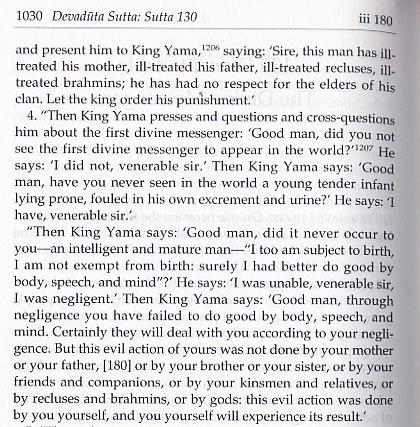




Yama

The god of death.¹ When beings die they are led before him to be judged according to their deeds. Birth, old age, illness, punishment for crime and death, are regarded as his messengers, sent among men as a warning to abstain from ill and do good. Yama questions beings brought before him as to whether they have seen these messengers and profited by them. If the answer is in the negative, the wardens of hell (nirayapālā) take them away to the different hells.²
In the Mahāsamaya Sutta ³ mention is made of two Yamas (duve Yamā), which the Commentary explains ⁴ by “dve Yamakadevatā” (the twins).⁵ Elsewhere,⁶ Buddhaghosa speaks of four Yamas (ima c’esa eko va hoti, catusu pana dvāresu cattāro janā honti) at the four gates (of hell ?). He says that Yama is a Vemānikapetarājā, who sometimes enjoys all the pleasures of heaven, in a celestial mansion, surrounded by wish-
In the Jātaka stories ⁷ the hells (niraya) are particularly mentioned as Yama’s abode (Yamakkhaya, Yamanivesana, Yamasādana, etc.) However, more generally, all saṃsāra is considered as subject to Yama’s rule, and escape from saṃsāra means escape from Yama’s influence, Yama being the god of Death. It is evidently in this sense that Yama is called Vesāyi ⁸ Yama is sometimes mentioned ⁹ with Indra, Varuṇa, Soma, Pajāpati, etc., as a god to whom sacrifices are offered. There is a tradition ¹⁰ that once Yama longed to be born as a human being and to sit at the feet of a Tathāgata.
Yama’s Nayanāyudha is mentioned ¹¹ among the most destructive of weapons.
Footnotes
¹ See, e.g., DhA.iii.337; Yamassa santikaṃ = Maranasantikaṃ.
² M.iii.180. ³ D.ii.259. ⁴ DA.ii.690.
⁵ Whom Rhys Davids calls the Castor and Pollux of Indian Mythology, in Dial.ii.290, n.1).
⁶ AA.i.374; MA.ii.953.
⁷ E.g., J.ii.318; iv.273; v.268, 274, 304. The Vetaranī is mentioned as forming the boundary of Yama’s kingdom (J.i.21; J.ii.317; iii.472; but see ii.318). At J.iv.405, Yama’s abode is called Ussadaniraya. DhA.i.334 explains Yamaloka by Catubbidhaṃ apāyalokaṃ. Cp. PvA.33 (Yamaloko ti petaloko); ibid., 107 (Yamavisayaṃ = Petalokaṃ).
⁸ J.ii.317, 318.
⁹ E.g., J.vi.201; D.i.244; at Mil.37 the list includes Kuvera, Suyāma, and Santusita; cp. Mtu i.265; iii.68, 77; 77, 307.
Finding Footnote References

References in the notes are to the Pāḷi texts of the PTS. In the translations, these are usually printed in the headers near the spine, or in square brackets in the body of the text, thus it would be iii 180 in the spine or [180] in the text. References to the Commentaries are usually suffixed with A for Aṭṭhakathā (DA, MA, SNA, etc.) but references to the Jātaka Commentary are given as J, not JA, which would normally be used, as that is reserved for the Journal Asiatic.
